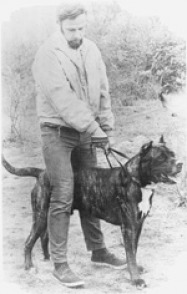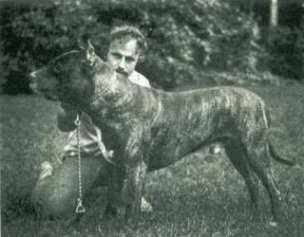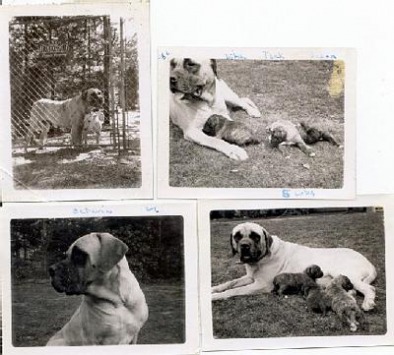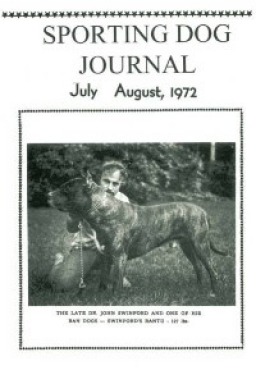Monsters of Molosser Kennels
History and Facts About the American Bandog Mastiff
The Bandog is designed to be a close quarter combat dog. It excels in realistic protection and can be a wonderful companion/family dog for experienced dog owners. They are quite trainable and easy to maintain. It is mainly good natured, fond of children in general, extremely devoted to its owner and eager to work. Appearance is muscular, behaviour is self assured, steady and fearless. It is basically a calm dog that transforms when a bad situation arises.
Bandog Size
Males:50-70 kg. (110 - 140 lbs)
Females:40-50 kg. (95 - 110 lbs)
Bandog Size
Males:50-70 kg. (110 - 140 lbs)
Females:40-50 kg. (95 - 110 lbs)
From wikipedia.org. "Anyone who is in the market for a great family dog that will be an intruder's nightmare should consider the Bandog"
Dr. John Bayard Swinford & the Swinford K-9

John Bayard Swinford, D.V.M., worked diligently in efforts to create the greatest of all modern canine companion guardians. As a result of his commitment, he and some friends developed the Swinford Bandog (Bandogge) over 40 years ago by using performance selection. This vision resulted in the creation of several large, powerful, athletic, drivey, stable minded dogs that most importantly were truly functional companion guard dogs. John's vision developed somewhat from seeing that many traditional working dogs suffer from poor selection. Show breeders were placing cosmetic appearance over the functional aspects that defined the various working canines and, in some cases, even before the general aspects of health itself. The traditional working Mastiffs had become only shadows of what they once were as they had lost balance, lacked structural soundness, lacked the necessary mental drives (unmotivated to work), and were generally lazy. Many even exhibited many behavioral problems. At one time canines had to earn their keep by effectively performing certain tasks. To awaken these lost abilities and to improve the effectiveness of the modern protection Mastiff type dogs, John desired to recreate the working Mastiff dog by once again selecting on performance over all other criteria...just as had been done for centuries before.

John Bayard Swinford, D.V.M., worked diligently in efforts to create the greatest of all modern canine companion guardians. As a result of his commitment, he and some friends developed the Swinford Bandog (Bandogge) over 40 years ago by using performance selection. This vision resulted in the creation of several large, powerful, athletic, drivey, stable minded dogs that most importantly were truly functional companion guard dogs. John's vision developed somewhat from seeing that many traditional working dogs suffer from poor selection. Show breeders were placing cosmetic appearance over the functional aspects that defined the various working canines and, in some cases, even before the general aspects of health itself. The traditional working Mastiffs had become only shadows of what they once were as they had lost balance, lacked structural soundness, lacked the necessary mental drives (unmotivated to work), and were generally lazy. Many even exhibited many behavioral problems. At one time canines had to earn their keep by effectively performing certain tasks. To awaken these lost abilities and to improve the effectiveness of the modern protection Mastiff type dogs, John desired to recreate the working Mastiff dog by once again selecting on performance over all other criteria...just as had been done for centuries before.
The foundation breeds
By using performance selection, John carefully selected various types of sound, protective mastiffs (primarily the English Mastiff) and bred them to performance proven "Bull-n-Terriers" (APBT) to produce the original Swinford Bandogs. Bantu, the dog pictured with John (above) was a first generation Swinford Bandog produced in the 1960's from the breeding of a proven "bull-n-terrier" stud (Kelly's "Bobtail Buddy" 2xW, not pictured) to an exceptional English Mastiff bitch known as "Octavia" (pictured below with young Bantu and litter mates).

One can clearly see the mother is an English Mastiff as has been reported in the Sporting Dog Journal. Swinford's most famous Bandog known as "Bantu" (pictured here as a pup with his mother) though was not actually the first Swinford Bandog nor was he even the first "Swinford's Bantu." Earlier John Swinford bred them previously and produced the first Swinford's Bantu; unfortunately, the first Bantu died from a car accident. After John Swinford's death in October of 1971, the second Swinford's Bantu became rather famous as a result of being published in both the July-August 1972 issue of Jack Kelly's Sporting Dog Journal and in Carl Semencic's first book.

As recorded in the Sporting Dog Journal
In the July-August 1972 issue of the Sporting Dog Journal, Jack Kelly wrote up a brief story about Swinfords Bandogs, which was the "cover story" of that issue. Some 30+ years later, Kelly again wrote a brief article of Swinford's work in a book. In both cases, Jack Kelly acknowledges the use of the English Mastiff being bred to game APBT dogs. In his book, Mr. Kelly states, "John was intent on establishing his very own breed of dog by crossing his English Mastiff to an American Pit Bull Terrier." In the 1972 July-August issue of the SDJ, Mr. Kelly gives referrence to the English Mastiff, the APBT, and also refers to some of the other foundation breeds used. It is in this journal that Mr. Kelly states, "John's ideas of breeding these dogs was to try and take the desirable qualities of each breed and through selective breeding to produce an all-purpose guard dog that was a game fighting dog." Mr. Kelly also gave reference to Swinford to the fact that even though Swinford himself did not keep pit dogs, he did love all dogs. He further described Swinford as a person who was always willing to offer his services to do whatever he could as a veterinarian for various dogs and dog clubs.
In the July-August 1972 issue of the Sporting Dog Journal, Jack Kelly wrote up a brief story about Swinfords Bandogs, which was the "cover story" of that issue. Some 30+ years later, Kelly again wrote a brief article of Swinford's work in a book. In both cases, Jack Kelly acknowledges the use of the English Mastiff being bred to game APBT dogs. In his book, Mr. Kelly states, "John was intent on establishing his very own breed of dog by crossing his English Mastiff to an American Pit Bull Terrier." In the 1972 July-August issue of the SDJ, Mr. Kelly gives referrence to the English Mastiff, the APBT, and also refers to some of the other foundation breeds used. It is in this journal that Mr. Kelly states, "John's ideas of breeding these dogs was to try and take the desirable qualities of each breed and through selective breeding to produce an all-purpose guard dog that was a game fighting dog." Mr. Kelly also gave reference to Swinford to the fact that even though Swinford himself did not keep pit dogs, he did love all dogs. He further described Swinford as a person who was always willing to offer his services to do whatever he could as a veterinarian for various dogs and dog clubs.
